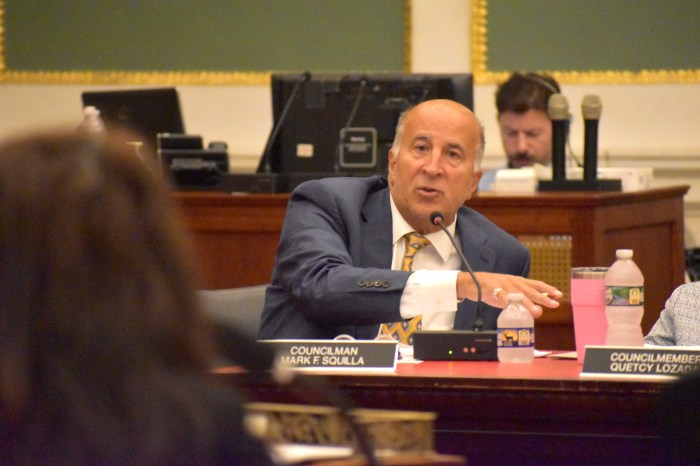A deluge of information about the 76ers’ proposal to build an arena in Center City dropped Monday night, as the city published long-awaited studies examining the project’s potential community, economic and transportation impacts, as well as its design.
Supporters and opponents of the controversial plan on Tuesday were still digesting the hundreds of pages, spread across four reports, that were released.
The team wants to move from the Wells Fargo Center into an 18,500-seat facility along Market Street in time for the 2031 NBA season. It would replace a section of the Fashion District mall between 10th and 11 streets.
An analysis of neighborhood impacts stated that the arena, known for now as 76 Place, “should be considered a significant potential risk to Chinatown’s core identity.”
Moderate changes could cause major disruptions for the area’s interconnected businesses and community organizations, wrote the consultants hired to conduct the community impact study.
Chinatown serves as a regional hub for the Asian American community, particularly those with limited English proficiency, according to the report. Many drive to access the neighborhood’s services, the study said, so any increase in traffic could dissuade visitors and customers.
About half of Chinatown businesses – more than 150 establishments – are projected to be negatively impacted by 76 Place, the consultants found. For another 30%, the impacts are expected to be mixed.
CSL, the firm hired for the financial analysis, determined that Philadelphia could support another viable indoor arena, alongside the Wells Fargo Center.
76 Place, in addition to basketball games, could attract more than 50 new third-party events to the city, including 35 concerts, without stealing any from the South Philadelphia sports complex, according to the report.
Through construction, which will take years, and three decades of operation, the arena would support more than 700 jobs and generate nearly $2 billion in direct spending, CSL said.
The analysis found that 76 Place could result in $249 million in additional tax revenue for the city and School District of Philadelphia over 30 years, far lower than the developer’s estimated $1 billion.
76DevCo, the team behind the project, has put out data predicting that 40% of fans will use public transit to get to the arena, which would be located above SEPTA’s Jefferson Station. They believe another 40% will drive.
In the transportation study, JMT determined that such a breakdown is “attainable,” if the 76ers provide support to SEPTA and PATCO. The team, the firm recommends, should provide transit passes with each ticket.
Even a slight increase in car traffic – say, 41% of fans using a private vehicle – could cause significant delays at some intersections, according to the analysis.
Design consultants, meanwhile, wrote that 76 Place needs more open public spaces where crowds can line up and gather before and after events.
The reports did not explicitly advocate for or against the project, and Mayor Cherelle Parker’s office noted that they were designed to provide “independent, neutral evaluations.”

City Councilmember Mark Squilla, who represents the East Market Street site, said both sides of the arena debate will find details to latch on to from the studies, and that he has yet to make up his mind.
Squilla’s support, or opposition, is crucial, given Council’s tradition of deferring to members about zoning issues within their own districts.
“I think, shortly, we have to decide whether to move forward or not,” he told Metro Tuesday. “It’s up to us as the elected body to come to a conclusion.”
Determining if concerns can be alleviated through legislative action or a community benefits agreement will be key, he added. Squilla said a decision over whether to introduce legislation authorizing the project is expected in the coming months. Lawmakers return to City Hall for their fall session next week.
Squilla has committed to sharing ordinances and resolutions for public review at least 30 days before formally introducing anything in Council. The legislation would also be subject to a public hearing.
Save Chinatown Coalition, a group of organizations opposed to the arena, began discrediting the studies months ago because they are being funded by the developers.
The city, under former Mayor Jim Kenney, required the 76ers pay for the studies through the Philadelphia Industrial Development Corporation to avoid using taxpayer money. City officials have said the team did not play a role in selecting the consultants or crafting the reports.
“As we continue carefully reviewing these documents in the coming days, it is clear these are not the studies the community asked for or the city needs,” said Vivian Chang, executive director of Asian Americans United, in a statement.
“Let’s be clear: Billionaire developers will benefit the most from 76 Place, and these studies are window dressing to obscure that fact,” added another Save Chinatown Coalition member, the Rev. Greg Edwards, executive director of POWER Interfaith. “Don’t fall for it.”

76DevCo, in a statement, said that, while they are still analyzing the reports, the findings show the arena can be built “in a way that protects our neighbors and maximizes benefit to Philadelphia.”
“It is clear already that they support what we’ve said since we first announced 76 Place: the arena is an appropriate use for Center City and will generate significant new jobs and tax revenue because Philadelphia can support two arenas,” a spokesperson for the development team continued.
The 76ers have pledged not to use city funds for the project, though the developers have said they are open to possibly receiving state or federal dollars.
Consultants for the studies were hired a year ago by the Kenney administration, and the community and economic impact reports were initially supposed to be released in the fall of 2023. Another deadline – the end of December – was also scrapped, with Kenney’s office opting to wait for a new mayoral administration.
All four studies are posted on the city’s website in English, Spanish and Simplified Chinese, and residents can submit feedback on the reports.



























